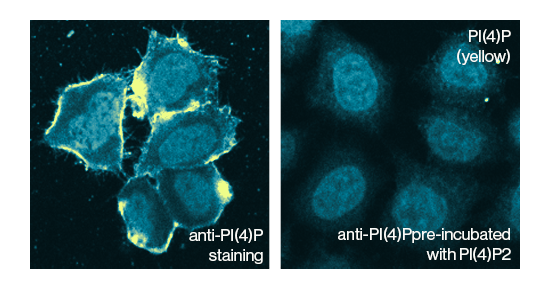Purified Anti-PtdIns(3,4,5)P3 monoclonal antibody.
Subclass: IgG1
Source: Mouse
Applications: ELISA, Alphascreen, Fluorescence Polarization, Protein-Lipid Overlay (PIP Strip)
Phosphoinositides (PIPns) are minor components of cellular membranes but are integral signaling molecules for cellular communication. Phosphatidylinositol 3,4,5-trisphosphate (PIP3), formed from PI(4,5)P2 though phosphorylation by PI 3-kinase, activates numerous signaling pathways resulting in cell proliferation, growth, survival, glucose transport and protein synthesis. High PIP3 levels from dysregulation of PI3-K have been demonstrated in cancer and inflammatory diseases. PIP3 is hydrolyzed by the phosphatases PTEN to PI(4,5)P2 and SHIP to PI(3,4)P2.
Featured in Publications
1) Sweeney, G., R. R. Garg, et al. (2004). “Intracellular delivery of phosphatidylinositol (3,4,5)-trisphosphate causes incorporation of glucose transporter 4 into the plasma membrane of muscle and fat cells without increasing glucose uptake.” J Biol Chem 279(31): 32233-42.
2) Papakonstanti, E. A., A. J. Ridley, et al. (2007). “The p110delta isoform of PI 3-kinase negatively controls RhoA and PTEN.” Embo J 26(13): 3050-61.
3) Maffucci, T., C. Raimondi, et al. (2009). “A phosphoinositide 3-kinase/phospholipase Cgamma1 pathway regulates fibroblast growth factor-induced capillary tube formation.” PLoS One 4(12): e8285.
4) Wang, Y., L. M. Weiss, et al. (2010). “Coordinate control of host centrosome position, organelle distribution, and migratory response by Toxoplasma gondii via host mTORC2.” J Biol Chem 285(20): 15611-8.
Product keywords: PIP3, PI(3,4,5)P3, PtdIns(3,4,5)P3, IgG, anti-PIP3




